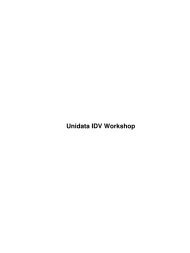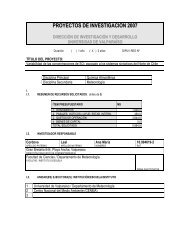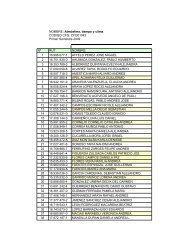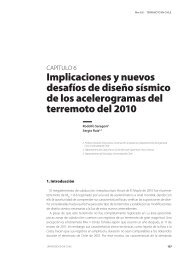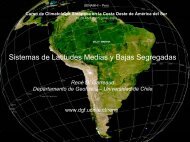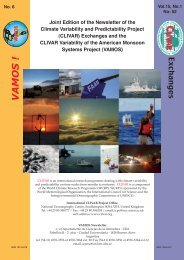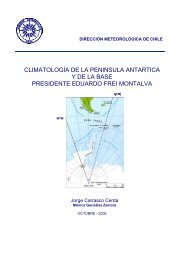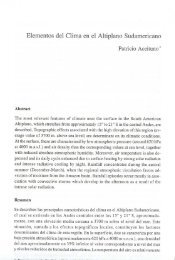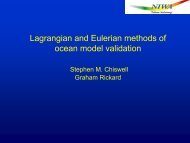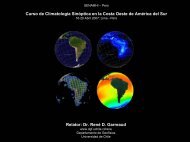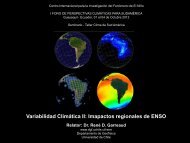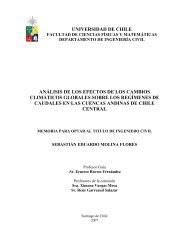Tema 9 Circulación General de la Atmósfera
Tema 9 Circulación General de la Atmósfera
Tema 9 Circulación General de la Atmósfera
Create successful ePaper yourself
Turn your PDF publications into a flip-book with our unique Google optimized e-Paper software.
<strong>Tema</strong> 9 <br />
<strong>Circu<strong>la</strong>ción</strong> <strong>General</strong> <strong>de</strong> <strong>la</strong> <strong>Atmósfera</strong> <br />
CFG2009: <strong>Atmósfera</strong>, Tiempo y Clima
Preguntas / puntos c<strong>la</strong>ves: <br />
1. ¿Qué le pasa a <strong>la</strong> energía so<strong>la</strong>r cuando llega <br />
al p<strong>la</strong>neta Derra <br />
2. ¿Por qué se producen <strong>la</strong>s estaciones <br />
3. La atmósfera como una máquina <strong>de</strong> calor <br />
4. Celda <strong>de</strong> Hadley / Régimen <strong>de</strong> Rossby <br />
5. Qué efecto producen los conDnentes <br />
CFG2009: <strong>Atmósfera</strong>, Tiempo y Clima
El P<strong>la</strong>neta Tierra es (aprox) esférico e inclinado <br />
respecto al p<strong>la</strong>no orbital (23.5º actualmente) <br />
CFG2009: <strong>Atmósfera</strong>, Tiempo y Clima
Imba<strong>la</strong>nce radiaDvo en el p<strong>la</strong>neta <br />
Ruddiman, 2008 <br />
CFG2009: <strong>Atmósfera</strong>, Tiempo y Clima
Tarea 6 <br />
averiguar el albedo (%) <strong>de</strong>: <br />
• Nieve fresca, hielo <br />
• Nieve vieja, <strong>de</strong>rriDendose <br />
• Nubes <br />
• Arena <strong>de</strong>l <strong>de</strong>sierto <br />
• Tierra <br />
• Tundra <br />
• PasDzales <br />
• Bosques <br />
• agua <br />
CFG2009: <strong>Atmósfera</strong>, Tiempo y Clima
La inclinación <strong>de</strong> <strong>la</strong> Derra, combinado con el movimiento <strong>de</strong> tras<strong>la</strong>ción <strong>de</strong> <strong>la</strong> Derra produce <br />
<strong>la</strong> alternancia <strong>de</strong> <strong>la</strong>s estaciones: máxima energía so<strong>la</strong>r en HS o HN. Factor <strong>de</strong> segundo <br />
or<strong>de</strong>n: excentricidad <strong>de</strong> <strong>la</strong> orbita terrestre (4% menos que el promedio en Enero, <br />
actualmente) <br />
Afelio: 4 Julio <br />
máx <br />
Perihelio: 4 Enero <br />
min <br />
CFG2009: <strong>Atmósfera</strong>, Tiempo y Clima
Alternancia <strong>de</strong> estaciones produce cambios en <strong>la</strong> energía so<strong>la</strong>r (al tope <strong>de</strong> <strong>la</strong> <br />
atmósfera) que reciben disDntas <strong>la</strong>Dtu<strong>de</strong>s a lo <strong>la</strong>rgo <strong>de</strong>l año <br />
30S <br />
60S <br />
CFG2009: <strong>Atmósfera</strong>, Tiempo y Clima
ecuador terrestre <br />
PS <br />
PN <br />
Déficit radia7vo <br />
Exceso <br />
radia7vo <br />
Déficit radia7vo <br />
Radiación so<strong>la</strong>r inci<strong>de</strong>nte <br />
Radiación terrestre emergente <br />
Transporte <strong>de</strong> calor <br />
en <strong>la</strong> atmósfera y océano <br />
La circu<strong>la</strong>ción <strong>de</strong> <strong>la</strong> atmósfera y océano distribuye el exceso <strong>de</strong> <br />
energía que reciben <strong>la</strong>s zonas tropicales hacia <strong>la</strong>Dtu<strong>de</strong>s altas, <br />
manteniendo así el equlibrio térmico <strong>de</strong>l p<strong>la</strong>neta <br />
CFG2009: <strong>Atmósfera</strong>, Tiempo y Clima
C<strong>la</strong>ramente, zonas tropicales reciben mas energía so<strong>la</strong>r que <strong>la</strong>Dtu<strong>de</strong>s altas. <br />
Consecuentemente zonas tropicales son mas cálidas. <br />
Sin embargo, su temperatura NO esta aumentando en forma permanente → <br />
equilibrio térmico <strong>de</strong>l p<strong>la</strong>neta <br />
Notar que Rad. Infraroja Emergente NO compensa diferencias ecuador polo <strong>de</strong> <br />
Rad. So<strong>la</strong>r <br />
CFG2009: <strong>Atmósfera</strong>, Tiempo y Clima
Qué produce el viento <br />
Calentamiento diferencial. <br />
Produce diferencias <strong>de</strong> presión. <br />
Viento sop<strong>la</strong> <strong>de</strong> altas presiones a bajas <br />
presiones. <br />
Efecto <strong>de</strong> Coriolis lo <strong>de</strong>svía. <br />
CFG2009: <strong>Atmósfera</strong>, Tiempo y Clima
Ejemplos:celdas <strong>de</strong> circu<strong>la</strong>ción térmica directa
Celda <strong>de</strong> circu<strong>la</strong>ción térmica directa <br />
Mo<strong>de</strong>lo simple <strong>de</strong> circu<strong>la</strong>ción <strong>de</strong> un fluido someDdo a una diferencia <strong>de</strong> <br />
temperatura en sus pare<strong>de</strong>s mantenida en el Dempo. <br />
t <br />
F <br />
C <br />
t+Δt <br />
F <br />
C <br />
CFG2009: <strong>Atmósfera</strong>, Tiempo y Clima
Simple, bonito…. <br />
Si sólo consi<strong>de</strong>ramos <strong>la</strong> <br />
circu<strong>la</strong>ción térmica directa, <br />
nuestro p<strong>la</strong>neta se vería <br />
así <br />
CFG2009: <strong>Atmósfera</strong>, Tiempo y Clima
Sin embargo, observaciones muestra una celda <strong>de</strong> circu<strong>la</strong>ción directa (celda <strong>de</strong> <br />
Hadley) restringida a ±30º <strong>la</strong>Dtud. <br />
Notar efecto <strong>de</strong> rotación terrestre en vientos Alisios (niveles bajos): NE / SE <br />
ZCIT: Zona <br />
convergencia <br />
intertropical <br />
ecuador <br />
Subsi<strong>de</strong>ncia <br />
subtropical <br />
Alisios (niveles bajos) <br />
CFG2009: <strong>Atmósfera</strong>, Tiempo y Clima
…pero <strong>la</strong> realidad es …. circu<strong>la</strong>ción <strong>de</strong> gran esca<strong>la</strong> <br />
2 circu<strong>la</strong>ciones directas: forzadas por calentamiento <br />
1 circu<strong>la</strong>ción indirecta: forzada por flujos <strong>de</strong> calor y <br />
momentum <strong>de</strong> remolinos <strong>de</strong> <strong>la</strong>Dtu<strong>de</strong>s medias (“eddies” ) <br />
CFG2009: <strong>Atmósfera</strong>, Tiempo y Clima
ZCIT <br />
CFG2009: <strong>Atmósfera</strong>, Tiempo y Clima
B<br />
B<br />
ZCIT <br />
ecuador <br />
A<br />
B<br />
A<br />
33S <br />
ZCIT asociado a un cinturon <strong>de</strong> bajas presiones. Subsi<strong>de</strong>ncia subtropical asociada a <br />
<strong>la</strong> formación <strong>de</strong> anDciclones subtropicales, interrumpidos por bajas conDnentales. <br />
CFG2009: <strong>Atmósfera</strong>, Tiempo y Clima
En <strong>la</strong>Dtu<strong>de</strong>s medias predominan vientos <strong>de</strong>l oeste…. <br />
SE <br />
W <br />
CFG2009: <strong>Atmósfera</strong>, Tiempo y Clima
En <strong>la</strong>Dtu<strong>de</strong>s medias y altura, también predominan los W. Corrientes en Chorro <br />
(Jet Stream, Máxima velocidad, >80 km/h) entre 30‐40º <strong>la</strong>t. <br />
SFC, Junio <br />
SFC, Enero <br />
12 km, Junio <br />
12 km, Enero <br />
CFG2009: <strong>Atmósfera</strong>, Tiempo y Clima
Régimen <strong>de</strong> Rossby <br />
Las corrientes en chorro son inestables... perturbaciones Den<strong>de</strong>n a amplificarse formando <br />
dorsales y vaguadas <strong>de</strong> gran amplitud, insDgando ciclogénesis y frontogénesis. <br />
CFG2009: <strong>Atmósfera</strong>, Tiempo y Clima
Las perturbaciones <strong>de</strong> <strong>la</strong>Dtu<strong>de</strong>s medias (ver c<strong>la</strong>se anterior) también transportan calor <br />
hacia <strong>la</strong>Dtu<strong>de</strong>s altas, conDnuando el proceso <strong>de</strong> transferencia <strong>de</strong> calor que realiza <strong>la</strong> <br />
atmósfera. <br />
Cálido <br />
Frio <br />
B<br />
500 hPa <br />
A <br />
CFG2009: <strong>Atmósfera</strong>, Tiempo y Clima
Corredores <strong>de</strong> tormentas <br />
(Varianza <strong>de</strong> vorDcidad, viento zonal, precipitación) <br />
Anual <br />
Junio <br />
Enero <br />
CFG2009: <strong>Atmósfera</strong>, Tiempo y Clima
CFG2009: <strong>Atmósfera</strong>, Tiempo y Clima
En resumen, <strong>la</strong> atmósfera realiza transporte <strong>de</strong> calor<br />
ecuador-polo por medio <strong>de</strong> <strong>la</strong> Celda <strong>de</strong> Hadley (<strong>la</strong>titu<strong>de</strong>s<br />
Tropicales/subtropicales) y el régimen <strong>de</strong> Rossby en<br />
<strong>la</strong>titu<strong>de</strong>s medias (Celda <strong>de</strong> Ferrel).<br />
CFG2009: <strong>Atmósfera</strong>, Tiempo y Clima
<strong>Circu<strong>la</strong>ción</strong> general <strong>de</strong> <strong>la</strong> atmósfera profundamente perturbada por presencia <strong>de</strong> <br />
masas conDnentales: diferencias en capacidad térmica y rugosidad. <br />
CFG2009: <strong>Atmósfera</strong>, Tiempo y Clima
CFG2009: <strong>Atmósfera</strong>, Tiempo y Clima
<strong>Circu<strong>la</strong>ción</strong> <strong>Atmósfera</strong> <br />
↓ <br />
<strong>Circu<strong>la</strong>ción</strong> Oceánica <br />
+ <br />
Bor<strong>de</strong>s conDnetales <br />
↓ <br />
Efectos locales en TSM <br />
CFG2009: <strong>Atmósfera</strong>, Tiempo y Clima
Mayor disponibilidad <strong>de</strong> vapor sobre los océanos → mayor precipitación <br />
Ene <br />
Jun <br />
CFG2009: <strong>Atmósfera</strong>, Tiempo y Clima
Sin embargo, mayor calentamiento sobre <br />
los conDnentes durante el verano produce <br />
celdas <strong>de</strong> Hadley locales…monsones <br />
conDnentales <br />
CFG2009: <strong>Atmósfera</strong>, Tiempo y Clima
Ruddiman, 2008 <br />
CFG2009: <strong>Atmósfera</strong>, Tiempo y Clima
Re<strong>la</strong>ción entre precipitación y biomasa <br />
CFG2009: <strong>Atmósfera</strong>, Tiempo y Clima
Finalmente, circu<strong>la</strong>ción general <strong>de</strong> <strong>la</strong> atmósfera (y océanos) + topograra + Dpo <br />
<strong>de</strong> suelo → biomasa caracterísDcos que son <strong>la</strong> base <strong>de</strong> sistemas <strong>de</strong> c<strong>la</strong>sificación <br />
climáDca <br />
CFG2009: <strong>Atmósfera</strong>, Tiempo y Clima
CFG2009: <strong>Atmósfera</strong>, Tiempo y Clima



